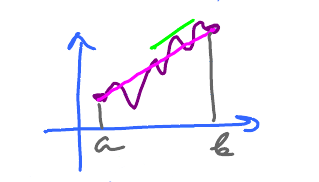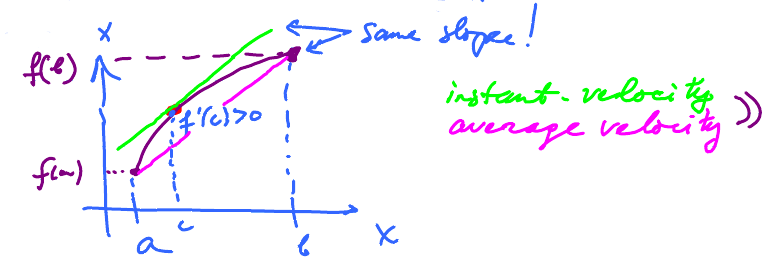This site is being phased out.
Derivative reflects behavior of the function
We consider some theory about how one can find out about the behavior of the function from its derivative.
Imagine that you:
- left home at 1pm,
- did some driving,
- came home at 2 pm.
Question: What can you say about your speed during this time?
For simplicity we assume that you drove on a straight road...
You may have driven slower and faster but this is the main thing: you came back home.
And to come back you had to turn around. To turn around you had to stop.
So, speed = 0 at least once!
Let's make this observation more mathematical and turn it into a theorem.
Let $x$ be time, limited to interval $[a,b]$, and $y=f(x)$ be your location at time $x$. Then speed/velocity corresponds to the derivative $f'$ of the function.
Theorem.
- $f$ is given, defined on $[a,b]$,
- $f$ is continuous on $[a,b ]$,
- $f$ is differentiable on $(a,b)$,
- $f(a) = f(b)$.
Then $f^{\prime}(c) = 0$ for some $c$ in $[a,b]$.
This is called Rolle's Theorem.
In the theorem, #2 means that you don't leap, #3 means that the velocity makes sense, #4 "I came back".
How do we prove it? What is this special point in time?
Consider the moment when you were farthest away from home (in either direction). That's the idea: you weren't moving then.
Proof.
Suppose $f$ has
- a global max at $x = c$ and
- a global min at $x = d$.
These assumptions are justified by the Extreme Value Theorem. ($\Rightarrow$ need continuity).
Recall Fermat's theorem:
- if $c$ is a local max them $f^{\prime}(c) = 0$.
- If $d$ is a local max then $f^{\prime}(c) = 0$.
We use the fact that every global max/min is a local max/min unless it's an end point.
Case 1. Neither $c$ nor $d$ is an end point, $a$ or $b$.
Then $f^{\prime}(c) = 0$ or $f^{\prime}(d) = 0$, done. (here $c$ or $d$ is in $(a,b)$).
Case 2. Both $c$ and $d$ are the end points, $a$ or $b$.
Then $$\left.\begin{aligned} f(c) & = f(a) \qquad \text{ or } \qquad f(c) = f(b) \\ f(d) & = f(a) \qquad \text{ or } \qquad f(d) = f(b) \end{aligned} \right\} \qquad \text{But these are equal!} $$ So, $$f(c) = f(d).$$ But this means that max=min!
Therefore $f$ is constant, so $f^{\prime}(x) = 0$ for all $x$. $\blacksquare$
This is important result but, generally, we don't expect to have $f(a) = f(b)$ (coming home). Let's generalize this result.
If we rotate the picture above, the result might look like this:
The picture suggests what happens to the entities we considered in Rolle's theorem:
- The tangents of those special points used to be horizontal and now they have become inclined.
- The line that connects the end points used to be horizontal and now is has become inclined.
But these lines are still parallel!
So, we need to find a connection between
- $f^{\prime}$ on $(a,b)$ (that's the velocity) and
- the slope of the line between $(a,f(a))$ and $(b,f(b))$ (that's the average velocity on $[a,b]$).
In terms of motion, this is what we see:
$\underbrace{f^{\prime} > 0}_{\text{Direction of motion is to the right.}}$ on $[a,b]$, so $\underbrace{f(b) > f(a)}_{\text{I moved to the right.}}$.
- Graphically
To illustrate, let's revisit the radar gun issue.
Radar gun catches the instantaneous velocity of the car. By law it shouldn't be above 70 m/h. When the radar gun shows anything above, you're caught.
Now, suppose there is no radar gun. Imagine instead a cop observed you in Huntington and then, after 30 minutes, in Charleston, 50 miles away.
Then the average speed of yours was 100 m/h. Bad, but did you violate the law?
The analysis we pursue here allows one to infer that yes, your instantaneous velocity was 100 m/h at some point. So, you were speeding!
Mean Value Theorem. Suppose
- $f$ is given on $[a,b]$,
- $f$ is continuous on $[a,b]$,
- $f$ is differentiable on $[a,b]$.
Then $$\underbrace{\frac{f(b) – f(a)}{b-a}}_{\text{The slope of the secant line, }g(x)} = f^{\prime}(c)$$ for some $c$ in $[a,b].$
In the equation:
- LHS = average velocity and
- RHS = instantaneous velocity over $[a,b]$ which is
$$ \frac{\text{displacement}}{\text{time}} $$
What happens if in MVT, $f(a) = f(b)$?
Then LHS = 0, then $0 = f^{\prime}( c)$. We have the conclusion of Rolle's Theorem. So, MVT is more general than RT. In other words, the latter is an instance, a narrow case of MVT.
How do we prove it?
Let's compare MVT and RT.
We rename $f$ as $h$ to use it later. Then the conditions of Rolle's Theorem look like this:
- $h$ is given, defined on $[a,b]$.
- $h$ is continuous on $[a,b]$.
- $h$ is differentiable on $[a,b]$.
- $ h(a) = h(b) $.
Let' also look at the graphs:
- Note 1
- In either case we are after $c$ with $f^{\prime}(c)$ equal the slope of the secant line.
- Note 2
- Graphs are similar.
Define $g(x)$ as the function represented by the secant line. We can only apply RT, to $h$ with $$ h(a) = h(b). $$ Unfortunately, $f$ is not like that.
Smart idea: let's try this. $$ h(x) = f(x) – g(x).$$ Since $$\begin{aligned} f(a) &= g(a) \\ f(b) &= g(b), \end{aligned}$$ it follows $$\begin{aligned} h(a) &= 0, \\ h(b) &= 0, \\ \Rightarrow h(a) &= h(b) \end{aligned}$$ This fits RT!
Next, $h$ is continuous on $[a,b]$ as the difference of the two continuous functions.
Also, $h$ is differentiable on $(a,b)$ as the difference of the two differentiable functions.
Thus $h$ satisfies the conditions of RT. Therefore the conclusion is satisfied too: $$\underbrace{h^{\prime}(c) = 0}_{\text{substitute } f,g \text{ to get MVT.}}$$ for some $c$ in $(a,b)$
We need a formula for $g$ now.
It's a straight line and its slope is $$ m = \frac{f(b) – f(a)}{b-a}, \qquad g \text{ is linear}.$$ Use the point-slope formula $$\begin{aligned} y – y_{0} &= m(x - x_{0}), \quad \text{or}\\ g(x) &= y_{0} + m(x – x_{0}) \end{aligned}$$ then $$g(x) = f(a) + m(x – a).$$ Then $$\begin{aligned} h(x) &= f(x) – g(x) \\ &= f(x) – f(a) - m(x – a). \end{aligned}$$ So $$\begin{aligned} h^{\prime}(x) & = f^{\prime}(x) - 0 - m, \quad \text{or} \\ h^{\prime}(x) &= f^{\prime}(x) - m \end{aligned}$$ By RT, $$ h^{\prime}(c) = 0 $$ for some $c$, so $$\begin{aligned} f^{\prime}(c) – m &= 0 \quad \text{or} \\ f^{\prime}(c) &= m. \end{aligned}$$ That's the LHS of MVT. $\blacksquare$
- Meaning of the theorem
- $$\text{Derivative at } c = \text{Slope of the secant line}$$
- $$\text{instantenous veliocity at some point in time} = \text{Average Velocity}$$
Example: If 100 miles covered in 1 hour, then was speeding at some point.
Consider this simple statement about motion:
"if my velocity is zero, I am standing still".
Suppose $f$ is the position, restate this mathematically.
Corollary. If $$f^{\prime}(x) = 0 \, \forall x$$ on an interval $(A,B)$, then $f$ is constant on $(A,B)$.
Proof. To prove that $f$ is constant, it suffices to show that $$f(a) = f(b)$$ for all $a,b$ in $(A,B)$.
Assume $a < b$ and use MVT ($(a,b) \subset (A,B)$): $$\frac{f(b) – f(a)}{b-a} =\begin{cases} f^{\prime}(c) & \text{for some } c \text{ in } (a,b) \\ =0 & \text{ny assumption, for all } c \text{ in } (a,b) \subset (A,B) \end{cases}$$ So $$\frac{f(b) - f(a)}{b-a} = 0$$ always. (Observe $(b-a) \neq 0$ as $b > a$.)
Hence $$f(b) – f(a) = 0$$ or $$f(a) = f(b).$$ $\blacksquare$
Let's take the opposite route this time. We state a theorem and then interpret it in terms of motion.
Corollary. If $$f^{\prime}(x) = g^{\prime}(x)$$ $\forall x$ in $(A,B)$, then $$f(x) – g(x)$$ is constant.
Geometrically, this means that the graphs are shifted vertically.
Restated for motion:
"If two runners run with the same speed, the distance between them isn't changing".
It's as if they are tied by a rope that will never break or hang.
Proof. Idea, define $$h(x) = f(x) – g(x).$$ Then $$\begin{aligned} h^{\prime}(x) &= (f(x) –g(x))^{\prime} \\ =f^{\prime}(x) –g^{\prime}(x) \\ =0, \forall x. \end{aligned}$$ Then $h$ is constant, by the previous corollary. $\blacksquare$





